消泡剂基础知识
- 格式:doc
- 大小:64.50 KB
- 文档页数:15
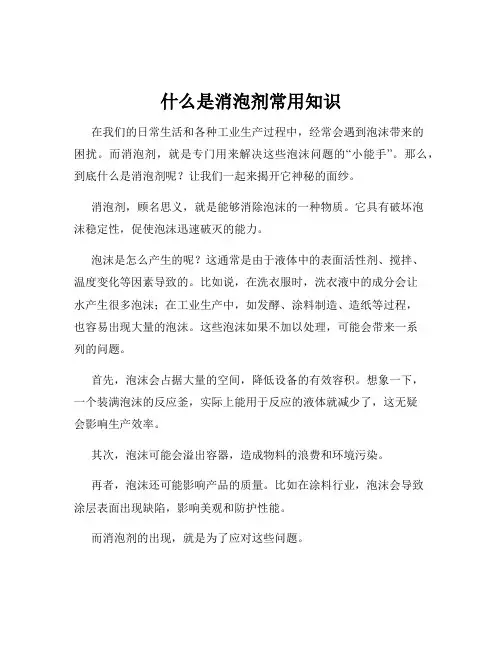
什么是消泡剂常用知识在我们的日常生活和各种工业生产过程中,经常会遇到泡沫带来的困扰。
而消泡剂,就是专门用来解决这些泡沫问题的“小能手”。
那么,到底什么是消泡剂呢?让我们一起来揭开它神秘的面纱。
消泡剂,顾名思义,就是能够消除泡沫的一种物质。
它具有破坏泡沫稳定性,促使泡沫迅速破灭的能力。
泡沫是怎么产生的呢?这通常是由于液体中的表面活性剂、搅拌、温度变化等因素导致的。
比如说,在洗衣服时,洗衣液中的成分会让水产生很多泡沫;在工业生产中,如发酵、涂料制造、造纸等过程,也容易出现大量的泡沫。
这些泡沫如果不加以处理,可能会带来一系列的问题。
首先,泡沫会占据大量的空间,降低设备的有效容积。
想象一下,一个装满泡沫的反应釜,实际上能用于反应的液体就减少了,这无疑会影响生产效率。
其次,泡沫可能会溢出容器,造成物料的浪费和环境污染。
再者,泡沫还可能影响产品的质量。
比如在涂料行业,泡沫会导致涂层表面出现缺陷,影响美观和防护性能。
而消泡剂的出现,就是为了应对这些问题。
消泡剂的种类繁多。
按照成分来分,常见的有有机硅类消泡剂、聚醚类消泡剂、矿物油类消泡剂等。
有机硅类消泡剂是应用比较广泛的一种。
它具有消泡效果好、持久性强的特点。
有机硅消泡剂的表面张力很低,能够迅速扩散到泡沫表面,降低泡沫的表面张力,从而使泡沫破裂。
聚醚类消泡剂则具有良好的水溶性和耐高温性能,在一些特殊的工业环境中表现出色。
矿物油类消泡剂成本相对较低,但消泡效果可能不如前两者那么显著。
除了成分不同,消泡剂还可以根据应用领域进行分类。
比如在食品工业中,使用的消泡剂需要符合食品安全标准;在医药领域,对消泡剂的纯度和安全性要求更高;而在工业生产中,不同的行业和工艺,对消泡剂的性能要求也各不相同。
消泡剂的作用原理主要有以下几种。
一是降低泡沫的表面张力。
就像前面提到的,通过降低表面张力,使泡沫变得不稳定,从而破裂。
二是破坏泡沫膜的弹性。
泡沫膜就像一个有弹性的“气球”,消泡剂能够让这个“气球”失去弹性,无法维持泡沫的形态。
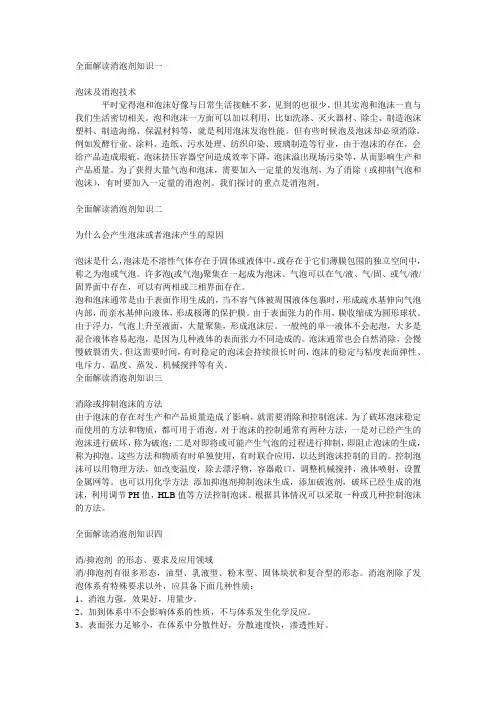
全面解读消泡剂知识一泡沫及消泡技术平时觉得泡和泡沫好像与日常生活接触不多,见到的也很少,但其实泡和泡沫一直与我们生活密切相关。
泡和泡沫一方面可以加以利用,比如洗涤、灭火器材、除尘、制造泡沫塑料、制造海绵、保温材料等,就是利用泡沫发泡性能。
但有些时候泡及泡沫却必须消除,例如发酵行业、涂料、造纸、污水处理、纺织印染、玻璃制造等行业,由于泡沫的存在,会给产品造成瑕疵,泡沫挤压容器空间造成效率下降,泡沫溢出现场污染等,从而影响生产和产品质量。
为了获得大量气泡和泡沫,需要加入一定量的发泡剂,为了消除(或抑制气泡和泡沫),有时要加入一定量的消泡剂。
我们探讨的重点是消泡剂。
全面解读消泡剂知识二为什么会产生泡沫或者泡沫产生的原因泡沫是什么,泡沫是不溶性气体存在于固体或液体中,或存在于它们薄膜包围的独立空间中,称之为泡或气泡。
许多泡(或气泡)聚集在一起成为泡沫。
气泡可以在气/液、气/固、或气/液/固界面中存在,可以有两相或三相界面存在。
泡和泡沫通常是由于表面作用生成的,当不容气体被周围液体包裹时,形成疏水基伸向气泡内部,而亲水基伸向液体,形成极薄的保护膜。
由于表面张力的作用,膜收缩成为圆形球状。
由于浮力,气泡上升至液面,大量聚集,形成泡沫层。
一般纯的单一液体不会起泡,大多是混合液体容易起泡,是因为几种液体的表面张力不同造成的。
泡沫通常也会自然消除,会慢慢破裂消失。
但这需要时间,有时稳定的泡沫会持续很长时间,泡沫的稳定与粘度表面弹性、电斥力、温度、蒸发、机械搅拌等有关。
全面解读消泡剂知识三消除或抑制泡沫的方法由于泡沫的存在对生产和产品质量造成了影响,就需要消除和控制泡沫。
为了破坏泡沫稳定而使用的方法和物质,都可用于消泡。
对于泡沫的控制通常有两种方法,一是对已经产生的泡沫进行破坏,称为破泡;二是对即将或可能产生气泡的过程进行抑制,即阻止泡沫的生成,称为抑泡。
这些方法和物质有时单独使用,有时联合应用,以达到泡沫控制的目的。
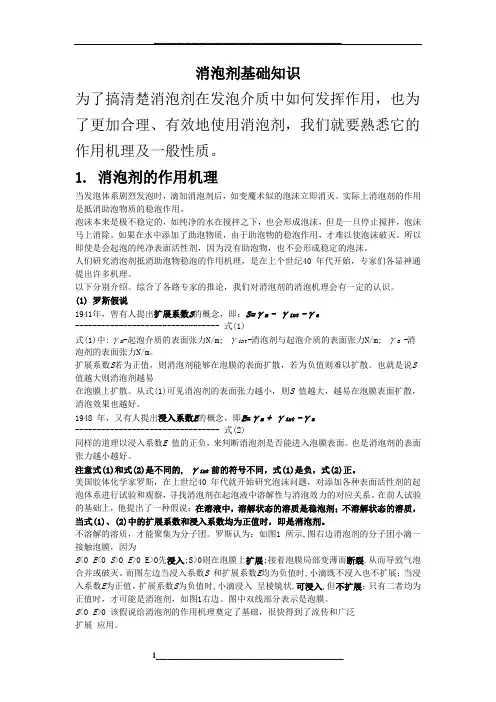
消泡剂基础知识为了搞清楚消泡剂在发泡介质中如何发挥作用,也为了更加合理、有效地使用消泡剂,我们就要熟悉它的作用机理及一般性质。
1. 消泡剂的作用机理当发泡体系剧烈发泡时,滴加消泡剂后,如变魔术似的泡沫立即消灭。
实际上消泡剂的作用是抵消助泡物质的稳泡作用。
泡沫本来是极不稳定的,如纯净的水在搅拌之下,也会形成泡沫,但是一旦停止搅拌,泡沫马上消除。
如果在水中添加了助泡物质,由于助泡物的稳泡作用,才难以使泡沫破灭。
所以即使是会起泡的纯净表面活性剂,因为没有助泡物,也不会形成稳定的泡沫。
人们研究消泡剂抵消助泡物稳泡的作用机理,是在上个世纪40 年代开始,专家们各显神通提出许多机理。
以下分别介绍。
综合了各路专家的推论,我们对消泡剂的消泡机理会有一定的认识。
(1) 罗斯假说1941年,曾有人提出扩展系数S的概念,即:S=γm - γint -γa--------------------------------- 式(1)式(1)中:γm-起泡介质的表面张力N/m; γint-消泡剂与起泡介质的表面张力N/m; γa -消泡剂的表面张力N/m。
扩展系数S若为正值,则消泡剂能够在泡膜的表面扩散,若为负值则难以扩散。
也就是说S 值越大则消泡剂越易在泡膜上扩散。
从式(1)可见消泡剂的表面张力越小,则S 值越大,越易在泡膜表面扩散,消泡效果也越好。
1948 年,又有人提出浸入系数E的概念,即E=γm + γint -γa--------------------------------- 式(2)同样的道理以浸入系数E 值的正负,来判断消泡剂是否能进入泡膜表面。
也是消泡剂的表面张力越小越好。
注意式(1)和式(2)是不同的, γint 前的符号不同,式(1)是负,式(2)正。
美国胶体化学家罗斯,在上世纪40 年代就开始研究泡沫问题,对添加各种表面活性剂的起泡体系进行试验和观察,寻找消泡剂在起泡液中溶解性与消泡效力的对应关系。
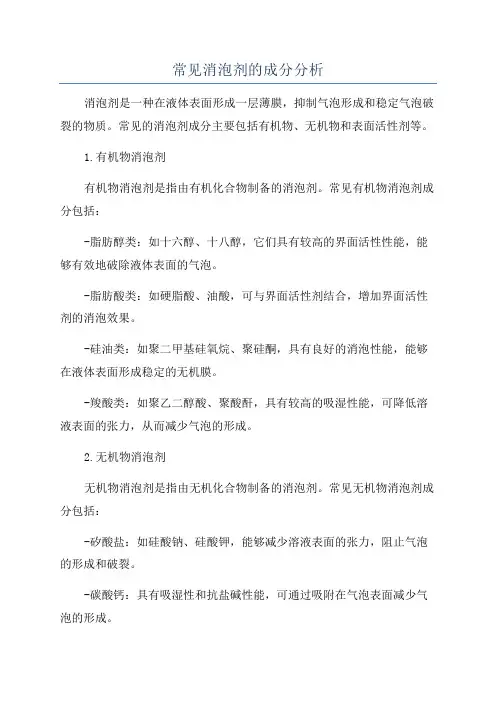
常见消泡剂的成分分析消泡剂是一种在液体表面形成一层薄膜,抑制气泡形成和稳定气泡破裂的物质。
常见的消泡剂成分主要包括有机物、无机物和表面活性剂等。
1.有机物消泡剂有机物消泡剂是指由有机化合物制备的消泡剂。
常见有机物消泡剂成分包括:-脂肪醇类:如十六醇、十八醇,它们具有较高的界面活性性能,能够有效地破除液体表面的气泡。
-脂肪酸类:如硬脂酸、油酸,可与界面活性剂结合,增加界面活性剂的消泡效果。
-硅油类:如聚二甲基硅氧烷、聚硅酮,具有良好的消泡性能,能够在液体表面形成稳定的无机膜。
-羧酸类:如聚乙二醇酸、聚酸酐,具有较高的吸湿性能,可降低溶液表面的张力,从而减少气泡的形成。
2.无机物消泡剂无机物消泡剂是指由无机化合物制备的消泡剂。
常见无机物消泡剂成分包括:-矽酸盐:如硅酸钠、硅酸钾,能够减少溶液表面的张力,阻止气泡的形成和破裂。
-碳酸钙:具有吸湿性和抗盐碱性能,可通过吸附在气泡表面减少气泡的形成。
-硅酸铝钠:具有良好的降泡性能,可以减少液体中的气泡。
3.表面活性剂消泡剂表面活性剂是一类能够降低液体表面张力的化合物,常用作消泡剂的成分包括:-阳离子表面活性剂:如石碱基二甲基溴化铵、椰子醇基二甲基溴化铵,能够在液体表面形成一层有机膜,有效地抑制气泡的形成。
-非离子表面活性剂:如辛醇聚氧乙烯醚、聚醚硅油,可降低液体表面的张力,减少气泡的形成。
-阴离子表面活性剂:如十二烷基硫酸钠、十二烷基苯磺酸钠,具有较强的消泡性能。
综上所述,常见消泡剂的成分包括有机物消泡剂、无机物消泡剂和表面活性剂消泡剂。
这些成分能够有效地降低液体表面的张力,阻止气泡的形成和稳定气泡的破裂,从而实现消泡的效果。
不同的消泡剂成分在不同的液体体系中具有不同的消泡效果,因此在使用消泡剂时需要根据具体的应用需求选择合适的成分。
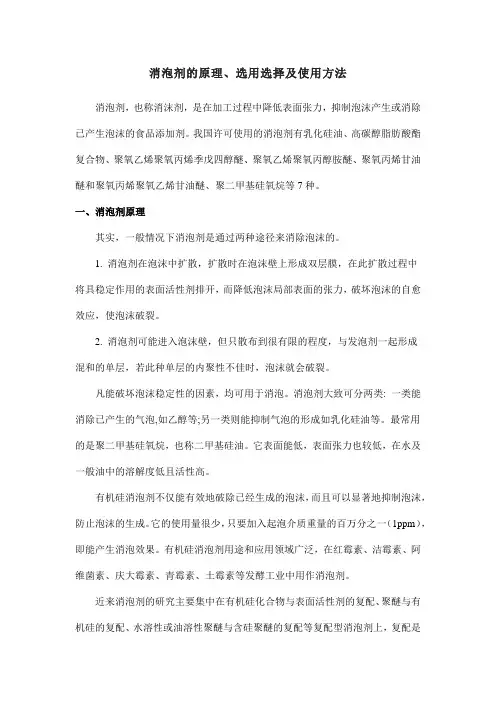
消泡剂的原理、选用选择及使用方法消泡剂,也称消沫剂,是在加工过程中降低表面张力,抑制泡沫产生或消除已产生泡沫的食品添加剂。
我国许可使用的消泡剂有乳化硅油、高碳醇脂肪酸酯复合物、聚氧乙烯聚氧丙烯季戊四醇醚、聚氧乙烯聚氧丙醇胺醚、聚氧丙烯甘油醚和聚氧丙烯聚氧乙烯甘油醚、聚二甲基硅氧烷等7种。
一、消泡剂原理其实,一般情况下消泡剂是通过两种途径来消除泡沫的。
1. 消泡剂在泡沫中扩散,扩散时在泡沫壁上形成双层膜,在此扩散过程中将具稳定作用的表面活性剂排开,而降低泡沫局部表面的张力,破坏泡沫的自愈效应,使泡沫破裂。
2. 消泡剂可能进入泡沫壁,但只散布到很有限的程度,与发泡剂一起形成混和的单层,若此种单层的内聚性不佳时,泡沫就会破裂。
凡能破坏泡沫稳定性的因素,均可用于消泡。
消泡剂大致可分两类: 一类能消除已产生的气泡,如乙醇等;另一类则能抑制气泡的形成如乳化硅油等。
最常用的是聚二甲基硅氧烷,也称二甲基硅油。
它表面能低,表面张力也较低,在水及一般油中的溶解度低且活性高。
有机硅消泡剂不仅能有效地破除已经生成的泡沫,而且可以显著地抑制泡沫,防止泡沫的生成。
它的使用量很少,只要加入起泡介质重量的百万分之一(1ppm),即能产生消泡效果。
有机硅消泡剂用途和应用领域广泛,在红霉素、洁霉素、阿维菌素、庆大霉素、青霉素、土霉素等发酵工业中用作消泡剂。
近来消泡剂的研究主要集中在有机硅化合物与表面活性剂的复配、聚醚与有机硅的复配、水溶性或油溶性聚醚与含硅聚醚的复配等复配型消泡剂上,复配是消泡剂的发展趋势之一。
就目前消泡剂而言,聚醚类与有机硅类消泡剂的性能最为优良,对这两类消泡剂的改性与新品种的开发研究也比较活跃。
二、消泡剂的用量和用法消泡活性物含量为100 % 的有机硅消泡剂较少直接用于生产过程,这不仅因成本高,而且少量使用时难奏效,用量多又会引起污染问题。
所以常用的大都是已配制成有机硅的质量分数为1%~2% 的消泡乳剂。
其用量根据工艺条件而适当变化。
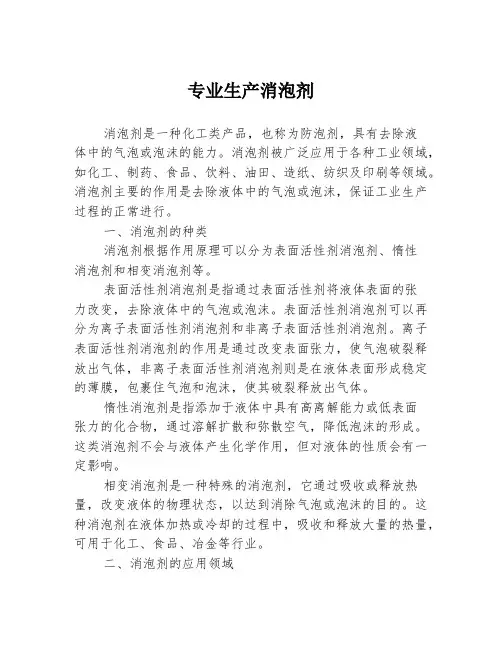
专业生产消泡剂消泡剂是一种化工类产品,也称为防泡剂,具有去除液体中的气泡或泡沫的能力。
消泡剂被广泛应用于各种工业领域,如化工、制药、食品、饮料、油田、造纸、纺织及印刷等领域。
消泡剂主要的作用是去除液体中的气泡或泡沫,保证工业生产过程的正常进行。
一、消泡剂的种类消泡剂根据作用原理可以分为表面活性剂消泡剂、惰性消泡剂和相变消泡剂等。
表面活性剂消泡剂是指通过表面活性剂将液体表面的张力改变,去除液体中的气泡或泡沫。
表面活性剂消泡剂可以再分为离子表面活性剂消泡剂和非离子表面活性剂消泡剂。
离子表面活性剂消泡剂的作用是通过改变表面张力,使气泡破裂释放出气体,非离子表面活性剂消泡剂则是在液体表面形成稳定的薄膜,包裹住气泡和泡沫,使其破裂释放出气体。
惰性消泡剂是指添加于液体中具有高离解能力或低表面张力的化合物,通过溶解扩散和弥散空气,降低泡沫的形成。
这类消泡剂不会与液体产生化学作用,但对液体的性质会有一定影响。
相变消泡剂是一种特殊的消泡剂,它通过吸收或释放热量,改变液体的物理状态,以达到消除气泡或泡沫的目的。
这种消泡剂在液体加热或冷却的过程中,吸收和释放大量的热量,可用于化工、食品、冶金等行业。
二、消泡剂的应用领域在化工生产中,发酵、氧化、溶剂提取、气吸和水处理等过程中都会产生大量气泡和泡沫。
这些气泡或泡沫会导致反应的不稳定和连续剧烈的气体排放等问题。
添加适量的消泡剂能有效去除液体中的气泡或泡沫,保证反应的稳定和顺利进行。
消泡剂的使用范围包括颜料、聚合物、树脂、塑料、涂料等化工产品的生产过程。
2、制药行业在制药生产过程中,浓缩、结晶、溶解、发酵等步骤中都会产生泡沫和气泡。
泡沫和气泡的存在会影响反应的纯度和产品的质量,并且会堵塞管道和过滤器等设备。
添加消泡剂能够快速去除气泡和泡沫,提高生产效率和产品质量,减少设备维护和清洗工作,降低生产成本。
3、食品饮料行业在食品和饮料加工中,液体中会产生大量的气泡和泡沫,如牛奶、啤酒、果汁、饮料等。
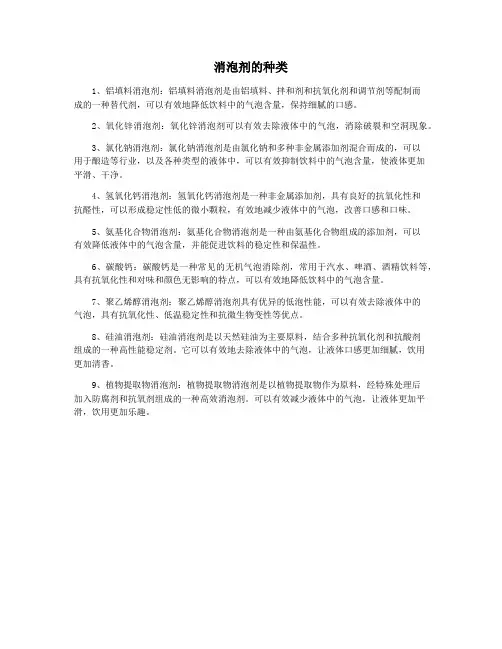
消泡剂的种类
1、铝填料消泡剂:铝填料消泡剂是由铝填料、拌和剂和抗氧化剂和调节剂等配制而
成的一种替代剂,可以有效地降低饮料中的气泡含量,保持细腻的口感。
2、氧化锌消泡剂:氧化锌消泡剂可以有效去除液体中的气泡,消除破裂和空洞现象。
3、氯化钠消泡剂:氯化钠消泡剂是由氯化钠和多种非金属添加剂混合而成的,可以
用于酿造等行业,以及各种类型的液体中,可以有效抑制饮料中的气泡含量,使液体更加
平滑、干净。
4、氢氧化钙消泡剂:氢氧化钙消泡剂是一种非金属添加剂,具有良好的抗氧化性和
抗醛性,可以形成稳定性低的微小颗粒,有效地减少液体中的气泡,改善口感和口味。
5、氨基化合物消泡剂:氨基化合物消泡剂是一种由氨基化合物组成的添加剂,可以
有效降低液体中的气泡含量,并能促进饮料的稳定性和保温性。
6、碳酸钙:碳酸钙是一种常见的无机气泡消除剂,常用于汽水、啤酒、酒精饮料等,具有抗氧化性和对味和颜色无影响的特点,可以有效地降低饮料中的气泡含量。
7、聚乙烯醇消泡剂:聚乙烯醇消泡剂具有优异的低泡性能,可以有效去除液体中的
气泡,具有抗氧化性、低温稳定性和抗微生物变性等优点。
8、硅油消泡剂:硅油消泡剂是以天然硅油为主要原料,结合多种抗氧化剂和抗酸剂
组成的一种高性能稳定剂。
它可以有效地去除液体中的气泡,让液体口感更加细腻,饮用
更加清香。
9、植物提取物消泡剂:植物提取物消泡剂是以植物提取物作为原料,经特殊处理后
加入防腐剂和抗氧剂组成的一种高效消泡剂。
可以有效减少液体中的气泡,让液体更加平滑,饮用更加乐趣。
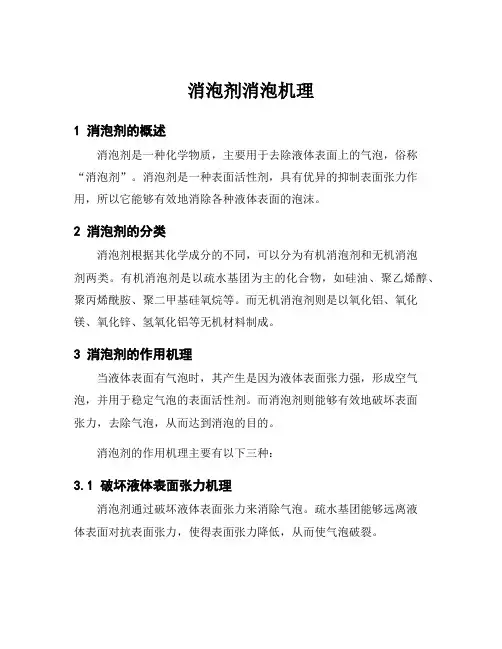
消泡剂消泡机理1 消泡剂的概述消泡剂是一种化学物质,主要用于去除液体表面上的气泡,俗称“消泡剂”。
消泡剂是一种表面活性剂,具有优异的抑制表面张力作用,所以它能够有效地消除各种液体表面的泡沫。
2 消泡剂的分类消泡剂根据其化学成分的不同,可以分为有机消泡剂和无机消泡剂两类。
有机消泡剂是以疏水基团为主的化合物,如硅油、聚乙烯醇、聚丙烯酰胺、聚二甲基硅氧烷等。
而无机消泡剂则是以氧化铝、氧化镁、氧化锌、氢氧化铝等无机材料制成。
3 消泡剂的作用机理当液体表面有气泡时,其产生是因为液体表面张力强,形成空气泡,并用于稳定气泡的表面活性剂。
而消泡剂则能够有效地破坏表面张力,去除气泡,从而达到消泡的目的。
消泡剂的作用机理主要有以下三种:3.1 破坏液体表面张力机理消泡剂通过破坏液体表面张力来消除气泡。
疏水基团能够远离液体表面对抗表面张力,使得表面张力降低,从而使气泡破裂。
3.2 破坏表面活性剂机理消泡剂的作用机理还可以通过破坏稳定气泡的表面活性剂来消除气泡。
消泡剂能够更好地吸附在液体表面,替代掉原有的活性剂,从而使气泡破裂。
3.3 减小气泡破裂力机理消泡剂能够减小气泡破裂时的能量,使气泡更容易破裂,从而达到消泡的目的。
4 消泡剂的应用领域消泡剂是一种广泛应用的工业化学品,可应用于以下领域:4.1 医药在药品的制造过程中,由于溶液的搅拌等原因,容易产生大量泡沫,会影响药品的制造和质量。
消泡剂可以有效地消除泡沫,提高药品的制造效率和质量。
4.2 食品在食品生产过程中,如酵母发酵、酒类生产、牛奶加热、果汁搅拌等,在液体表面上形成的泡沫会影响生产效率和产品质量。
消泡剂可以有效地消除泡沫,提高生产效率和产品质量。
4.3 化工在化工生产过程中,如合成树脂、颜料、涂料等,由于液体表面张力强,容易产生大量泡沫,影响产品的制作和质量。
消泡剂可以消除泡沫,提高产品的制作效率和质量。
5 小结消泡剂是一种表面活性剂,能够有效地抑制液体表面张力,从而消除液体表面上的气泡。
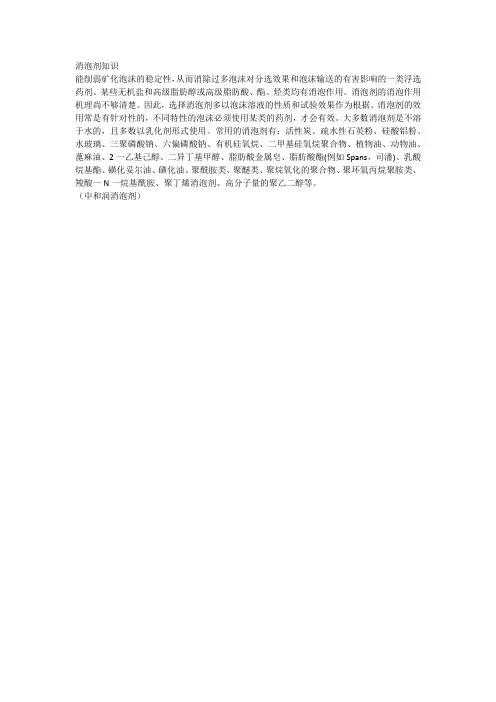
消泡剂知识
能削弱矿化泡沫的稳定性,从而消除过多泡沫对分选效果和泡沫输送的有害影响的一类浮选药剂。
某些无机盐和高级脂肪醇或高级脂肪酸、酯、烃类均有消泡作用。
消泡剂的消泡作用机理尚不够清楚。
因此,选择消泡剂多以泡沫溶液的性质和试验效果作为根据。
消泡剂的效用常是有针对性的,不同特性的泡沫必须使用某类的药剂,才会有效。
大多数消泡剂是不溶于水的,且多数以乳化剂形式使用。
常用的消泡剂有:活性炭、疏水性石英粉、硅酸铝粉、水玻璃、三聚磷酸钠、六偏磷酸钠、有机硅氧烷、二甲基硅氧烷聚合物、植物油、动物油、蓖麻油、2一乙基己醇、二异丁基甲醇、脂肪酸金属皂、脂肪酸酯(例如Spans,司潘)、乳酸烷基酯、磺化妥尔油、磺化油、聚酰胺类、聚醚类、聚烷氧化的聚合物、聚环氧丙烷聚胺类、羧酸一N一烷基酰胺、聚丁烯消泡剂、高分子量的聚乙二醇等。
(中和润消泡剂)。
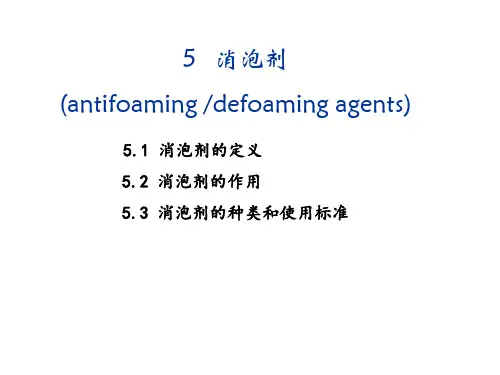
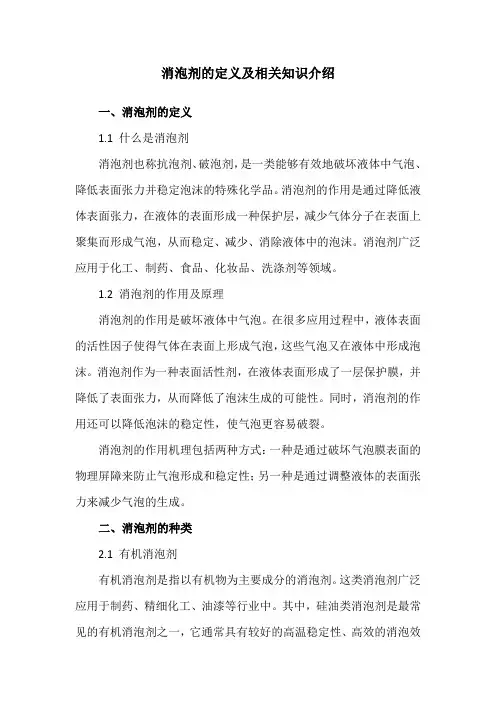
消泡剂的定义及相关知识介绍一、消泡剂的定义1.1 什么是消泡剂消泡剂也称抗泡剂、破泡剂,是一类能够有效地破坏液体中气泡、降低表面张力并稳定泡沫的特殊化学品。
消泡剂的作用是通过降低液体表面张力,在液体的表面形成一种保护层,减少气体分子在表面上聚集而形成气泡,从而稳定、减少、消除液体中的泡沫。
消泡剂广泛应用于化工、制药、食品、化妆品、洗涤剂等领域。
1.2 消泡剂的作用及原理消泡剂的作用是破坏液体中气泡。
在很多应用过程中,液体表面的活性因子使得气体在表面上形成气泡,这些气泡又在液体中形成泡沫。
消泡剂作为一种表面活性剂,在液体表面形成了一层保护膜,并降低了表面张力,从而降低了泡沫生成的可能性。
同时,消泡剂的作用还可以降低泡沫的稳定性,使气泡更容易破裂。
消泡剂的作用机理包括两种方式:一种是通过破坏气泡膜表面的物理屏障来防止气泡形成和稳定性;另一种是通过调整液体的表面张力来减少气泡的生成。
二、消泡剂的种类2.1 有机消泡剂有机消泡剂是指以有机物为主要成分的消泡剂。
这类消泡剂广泛应用于制药、精细化工、油漆等行业中。
其中,硅油类消泡剂是最常见的有机消泡剂之一,它通常具有较好的高温稳定性、高效的消泡效果和广泛的使用范围。
2.2 无机消泡剂无机消泡剂是指以无机物为主要成分的消泡剂。
这类消泡剂常常用于研发防火及其他建筑材料,以及一些高温、酸碱及粘度要求高的体系。
2.3 界面活性剂类消泡剂界面活性剂类消泡剂的作用机理基于表面活性物质本身的作用。
这类消泡剂广泛应用于制药、食品和化妆品中。
譬如,膦酸类、阴离子表面活性剂、阳离子表面活性剂、非离子表面活性剂、两性表面活性剂等均属于此类。
2.4 聚合物类消泡剂聚合物类消泡剂是通过高分子聚合物的增稠效应和缩小气泡尺寸,有效地降低气泡生成和抑制泡沫形成。
这类消泡剂通常用于管道输送、化工反应、造纸等工业领域中。
2.5 生物类消泡剂生物类消泡剂主要通过利用细菌或酵母发酵所产生的发酵产物,来破化液体中的气泡。
消泡剂的知识介绍消泡剂不知道大家知道多少,消泡剂又称之为抗炮剂,顾名思义就是处理化学工业生产中产生的有害泡沫的,总体简单来说,消泡剂具有破泡、脱泡、抑泡的作用,其用途非常的广泛,主要体现在以下一个方面:消泡剂通常含有疏水性沉淀法二氧化硅分散在矿物油或硅油中。
实际上用于消泡剂的二氧化硅的粒径越大,越容易沉淀,特别是在低粘度分散体系中。
加入疏水性气相法二氧化硅有可以完全防止或者能明显减少这个沉降过程。
气相二氧化硅中硅醇基团像很多的的针一样,刺破气泡,使小气泡汇聚成大气泡,溢出体系,达到消泡的作用。
在有些消泡体系中,疏水性气相法二氧化硅也可以是有消泡作用的二氧化硅组分,气相二氧化硅在消泡剂中起到增稠防沉降等作用,更重要的是增强消泡能力和提高抑泡能力。
1、合成橡胶以及树脂工业领域,我们知道在使用一些乳胶合成的手套的时候,因为其主要的材料采用的是脂肪酸皂作为乳化剂,因此在使用的过程中起泡现象会比较严重,特别是在作用结束之后,当汽提反应未反应单体的时候,这个现象会更为严重,在这些复杂的化学制产品的反应的过程中产生的气泡。
这些气泡不仅使得在生产过程中的生产效率受到大大的影响,同时会造成原料以及产品的浪费,延长了产品的反应周期,同时还会污染环境,因此在一些会有泡沫产生的过程中就将这种可能性降低到最小或者抑制住,那就是消泡剂。
将消泡剂使用在这些向橡胶制品中能够提高产品的稳定性能,提高产品的耐磨性,特别是对于一些需要染色的产品,能够提高其上色度。
2、石油工业中,在国家的石油化工领域中消泡剂也是得到了广泛的使用,在石油提炼的过程中,特别是在原油蒸馏的过程中,蒸馏出来的气体泡沫会影响到产品的生产效率,使用消泡剂的话会实现高效率的连续性运转。
同时消泡剂在纺织工业中应用也比较广泛!每日精彩内容,订阅吧!。
关于消泡剂的基础知识使用消泡剂的方法及注意事项(1)添加方法1)间隙添加-常用的方法如果不是连续起泡,而且起泡不严重,则可将消泡剂一次加入或定时加入。
因为消泡剂添加量较小,为使消泡剂分散均匀,应该在起泡液湍动剧烈的地方添加。
许多场合可以手工添加。
若起泡猛烈或者为了迅速灭泡,可以用喷枪喷射。
如果在一定限度内允许泡沫存在,只是为了防止泡沫过多,则可将不溶性的、高效硅膏状消泡剂涂抹在容器壁液面上部边缘,或者将其涂敷在金属网或其它纺织品网之上,覆盖在容器的一定位置。
泡沫层升高接触到硅膏消泡剂即可破灭,从而阻挡泡沫溢出。
一次加入不够,可多次加入或定时加入。
2) 连续添加-生产规模较大消泡剂加入后,从开始起消泡作用也开始失效。
间歇添加的消泡剂,却在连续地损耗,当含有的消泡剂不足以控制泡沫时,就需要补充添加。
图7 反映补充添加消泡剂时体系中消泡剂有效量的变化情况。
图中有斜线的长方形面积,是消泡剂的必要消耗量。
图中长方形面积和上面三角形面积之和是消泡剂的实际消耗量。
而三角形面积是消泡剂无意义消耗量。
由图7 可见,B 图消泡剂无意义消耗量比A 图少。
显然,如果我们掌握消泡剂的必要消耗量,就能实现连续添加,可以节约消泡剂的用量,避免无意义的消耗。
连续添加,可将消泡剂加入设备上面的高位槽内,高位槽搁置在设备湍动剧烈处,按照消泡剂实际需要量,,连续向设备内滴加。
如果设备是压力系统,可用计量泵加入。
3) 自控添加-比较先进任何起泡液不一定自始至终都在起泡。
何时起泡,泡量的大小没有准确的规律。
添加消泡剂是为了补充消耗,不起泡时无须添加。
因此可以采取自控添加方法,根据起泡先兆,自控添加消泡剂。
自控装置要依据各种装置的特点来设计,添加一些必要仪表控制。
比较适合于自控添加的是,大型化工蒸馏塔、吸收塔、聚合釜等等。
(2) 注意事项1) 稀释消泡剂添加量一般很少,对于起泡体系添加的消泡剂活性含量从1ppm~100ppm, 食品级的消泡剂一般建议用量10ppm 。
关于消泡剂的详解导读:水处理中的泡沫问题困扰了很多的人,调试初期泡沫、表面活性剂泡沫,冲击泡沫,过氧化泡沫,循环水处理中投加非氧化性杀菌剂产生的泡沫等等,所以水处理中消泡剂的使用就比较常见了,本文介绍消泡剂的原理、分类、选型及用量!水处理中的泡沫问题困扰了很多的人,调试初期泡沫、表面活性剂泡沫,冲击泡沫,过氧化泡沫,循环水处理中投加非氧化性杀菌剂产生的泡沫等等,所以水处理中消泡剂的使用就比较常见了,本文全面介绍消泡剂的原理、分类、选型及用量!1、泡沫的消除方法1、物理方法从物理学角度考虑消除泡沫的方法主要包括放置挡板或滤网、机械搅拌、静电、冷冻、加热、蒸汽、射线照射、高速离心、加压减压、高频振动、瞬间放电和超声波(声学液体控制)等,这些方法都在不同的程度上促进了液膜两端气体的透过速率和泡膜的排液,使得泡沫的稳定因素小于衰减因素,从而泡沫的数量逐渐减少。
但是这些方法共同的缺点是使用受环境因素的制约性较强、消泡速率不高等,优点在于环保、重复利用率高。
2、化学方法从化学角度消除泡沫的方法主要包括化学反应法和添加消泡剂的方法。
化学反应法是指通过加入一些试剂使其与起泡剂发生化学反应,生成不溶于水的物质,从而降低了液膜中表面活性剂的浓度,促使泡沫的破裂,但是这种方法存在发泡剂成分不确定、产生难溶性物质对体系设备产生危害等缺点。
现如今各行各业应用广泛的消泡方法是加入消泡剂的方法,这种方法最大的优点在于破泡效率高、使用方便等优点,但是寻找合适高效的消泡剂是关键。
2、消泡剂的原理消泡剂,也称消沫剂,原理有以下几点:1、泡沫局部表面张力降低导致泡沫破灭该种机理的起源是将高级醇或植物油撒在泡沫上,当其溶入泡沫液,会显著降低该处的表面张力。
因为这些物质一般对水的溶解度较小,表面张力的降低仅限于泡沫的局部,而泡沫周围的表面张力几乎没有变化。
表面张力降低的部分被强烈地向四周牵引、延伸,最后破裂。
2、破坏膜弹性而导致气泡破灭消泡剂添加到泡沫体系中,会向气液界面扩散,使具有稳泡作用的表面活性剂难以发生恢复膜弹性的能力。
制作消泡剂常用知识点总结消泡剂是一种可以减少液体表面张力,阻碍气泡形成和稳定的化学物质。
在许多行业中,如食品加工、化妆品生产、药品制造、油漆和涂料制造以及水处理等领域,消泡剂都扮演着重要的角色。
因此,了解消泡剂的制作方法和应用是非常重要的。
本文将总结一些制作消泡剂常用的知识点,希望能够对相关行业的从业者有所帮助。
1. 消泡剂的分类消泡剂主要可以分为有机消泡剂和无机消泡剂两大类。
有机消泡剂一般是一些表面活性剂,如硅油、聚醚类物质等;而无机消泡剂一般是以氢氧化铝、氧化锌等无机成分为主要原料制成的。
2. 消泡剂的原理消泡剂的作用原理是通过改变液体的表面张力,减少气泡在液体中的形成,并破坏原有的气泡结构,从而达到抑制气泡的目的。
3. 消泡剂的制作方法消泡剂的制作方法一般包括以下几个步骤:(1)选择适合的原料:消泡剂的原料选择非常重要,一般需要选择具有一定的稳定性和活性的化学物质作为主要原料。
(2)混合原料:根据不同的消泡剂类型,将不同的原料按照一定的配比混合均匀。
(3)加工制备:根据不同的生产工艺和技术要求,将混合好的原料进行加工制备成消泡剂的成品。
4. 消泡剂的应用消泡剂广泛应用于食品工业、造纸工业、油漆和涂料工业、水处理工业等各个领域,主要是为了减少气泡和泡沫的产生,并提高生产效率和产品质量。
5. 消泡剂的市场前景随着各个行业的发展和需求不断增加,消泡剂的市场前景也非常广阔。
特别是在食品工业和水处理工业领域,消泡剂的需求量一直保持着稳定增长的态势。
总之,消泡剂作为一种重要的化学品,在各个行业中都担当着非常重要的角色。
掌握消泡剂的制作知识和应用技术,将有助于提高生产效率,改善产品质量,促进工业发展和经济增长。
希望本文的总结能够对相关行业的从业者有所帮助,促进消泡剂产业的持续发展。
消泡剂的添加方法用量及步骤消泡剂,这东西听起来是不是有点高大上?其实说白了,它就是用来消灭那些让我们烦恼的泡泡的“英雄”。
在某些行业,泡泡可是个大麻烦,像是在生产过程中,它们会妨碍液体的流动,甚至影响到产品的质量。
今天就让我们轻松聊聊怎么用消泡剂,让这些泡泡无处遁形。
1. 消泡剂的基本知识1.1 什么是消泡剂?首先,消泡剂到底是什么呢?其实,它是一种化学物质,专门用来降低液体表面张力,从而减少或消除液体中的泡沫。
就像我们吃火锅的时候,往锅里加点油,油能让水面上的泡泡变少,消泡剂就是那种“神奇的油”。
不过,这玩意儿可不是随便加的,咱得掌握点窍门,才能玩得转。
1.2 消泡剂的种类说到消泡剂,市面上可不是只有一种。
我们常见的有有机硅消泡剂、聚醚消泡剂,还有一些天然的消泡剂,比如植物提取物。
每种消泡剂的适用范围都不一样,就像每个人的性格都不同,有的人适合当领导,有的人适合当文艺青年。
所以,选对消泡剂才是关键哦!2. 消泡剂的添加方法2.1 添加前的准备在你准备添加消泡剂之前,首先得了解一下你的液体状态。
比如,是不是已经有很多泡泡了?这个步骤就像你去买衣服,得先知道自己穿什么码。
然后,再检查一下你要使用的消泡剂的说明书,这可是你最好的“助手”,让你更顺利。
2.2 添加步骤好,进入正题!在添加消泡剂的时候,建议你先从小剂量开始。
这就像调味料一样,太多了反而会出乱子。
一般来说,消泡剂的用量在0.1%到1%之间,具体还是得看泡泡的“造访”情况。
先在容器的一边慢慢倒入,最好用搅拌器轻轻搅拌。
就像你在调咖啡,慢慢来,不要急。
一旦泡泡开始减少,你就可以再观察一下,如果还是有点“任性”,那就再加一点。
记住,添加的过程就像是和泡泡的斗智斗勇,耐心点,别着急。
大多数时候,泡泡不都是一两下就能搞定的,得耐心点儿。
3. 消泡剂的使用技巧3.1 合理用量要想真正消灭泡泡,合理的用量很重要。
太少的话,可能效果不明显;太多又容易影响到液体的其他性质。
消泡剂概述一、消泡剂存在的意义泡沫的存在严重影响生产,因此需要消除泡沫。
常见的消泡方法分为物理法和化学法。
物理法主要包括放置挡板或滤网、静电、冷冻、加热、高速离心、加压减压、高频振动、超声波等,这些方法都是通过物理作用使气泡的稳定因素减弱,主要原理都是影响液膜内外气体透过速率以及液膜厚度,从而消除泡沫。
但是这些方法的缺点主要是需要添加额外设备,装置成本较高,同时消泡时间较长、破泡不彻底等。
化学法主要是化学反应法和添加消泡剂法,化学反应法主要是通过向发泡体系中添加某种物质与体系中发泡物质反应,或者是生成某种具有消泡作用的物质,使泡沫破除。
但是这种方法的主要问题是生成物不确定,影响生产过程;反应受到其他物质影响难以反应等缺点,使其消泡目的难以达到。
添加专用消泡剂法是现在各行业主要应用的方法,因为该法具有消泡快、抑泡时间长、使用方便,不影响生产过程等优点。
消泡剂主要有两方面作用:一方面是“消泡”,顾名思义即消除已经产生的泡沫;另一方面是“抑泡”,即对发泡体系,有抑制作用,防止泡沫的产生。
一种性能优异的消泡剂应具备以下条件:(1)消、抑泡性能好,见效快,用量少。
(2)化学惰性。
当加入到发泡体系,不会影响其生产过程,不改变发泡体系基本性质。
(3)表面张力小,要低于发泡体系,这样才能快速在发泡体系中铺展和分散。
(4)不溶于发泡体系,易于扩散和渗透。
(5)无毒,无污染,安全性好。
(6)耐酸碱性、耐高低温,贮藏稳定性好。
二、消泡剂发展1、第一代消泡剂——有机类消泡剂主要包括醇类物质、油脂类、胺和酰胺类等。
此类消泡剂优点:来源广泛易得,价格比较便宜。
一般适用于发泡能力较低的体系,但是对于致密性泡沫破除率低,而且易对发泡体系产生影响,所以其发展受到限制。
目前,该类消泡剂在造纸行业应用较多。
2、第二代消泡剂——聚醚类消泡剂它主要包括以下几种:(1)直链聚醚,如环氧乙烯的加聚物、聚丙二醇等;(2)聚氧乙烯醇及其衍生物、二戊胺、聚乙烯氨胺等。
FAQs (Frequently Asked Questions)1. Who is Ultra Additives, Inc.?2. What products does Ultra Additives sell?3. What markets are Ultra Additives products used in?4. Where is Ultra Additives, Inc., located?5. How do I contact Ultra Additives, Inc.?6. Is Ultra Additives, Inc. an ISO registered company?7. Who is Münzing Chemie GmbH?8. How do I contact Münzing Chemie GmbH?9. What does Münzing Chemie’s future hold?10. What is foam?11. What is the difference between a defoamer and an antifoam agent?12. Why and when do I need to use a defoamer?13. What types of defoamers does Ultra Additives have in its product line?14. What are the benefits of Ultra Additives’ defoamers?15. How do I know which type of defoamer to select?16. What problems can the wrong defoamer cause?17. When do I inoculate a defoamer into a formulation?18. How do I properly incorporate a defoamer?19. How do you test for defoamer stability in a formulation?20. How do you test for the propensity of a defoamer to rupture foam in a system?21. Are Ultra Additives' defoamers rinsable?22. What are the applicat ions for Ultra Additives’ powder defoamers?23. What is ZINPLEX 15®?24. What properties does ZINPLEX 15® enhance?25. What are the formulation guidelines for using ZINPLEX 15®?26. What is a polyurethane rheology modifier?27. Why should I use polyurethane rheology modifiers?28. How do I select the proper thickener for my formulation?29. How do I test for a thickener’s effectiveness?30. What are the benefits of Ultra Additives’ Polyurethane Rheology Modifiers (TAFIGEL® PUR)?31. What are the applications for Ultra Additives’ Polymeric Dispersants (EDAPLAN®)?32. What are the advantages of Ultra Additives’ EDAPLAN® Polymeric Dispersants?33. What are the applications for Ultra Additives’ Anti-Shrinkage Agents and Coalescents34. What are the benefits of Ultra Additives’ METOLAT® P Anti-shrinkage Agents and Coalescents?35. How do I find out about the FDA status of a particular Ultra Additivesproduct?36. Whom do I contact at Ultra Additives if I would like to have technical service work performed on my formulation?37. If I am using a particular polymer, can Ultra Additives, Inc., recommend applicable defoamers to help complete my formulation?Who is Ultra Additives, Inc.?Drawing on knowledge and experience developed over 50 years, Ultra Additives, Inc., has matured into one of today’s most progressive developers and manufacturers of antifoam/defoaming agents. Ultra Additives markets its products under the trade names DEE FO®, FOAM BAN™, FOAMTEX®, FOAMTROL, and JETBURST®.In May 2000, Ultra Additives, Inc., was acquired by the German-based company Münzing Chemie GmbH. This historic pairing of two leaders in the performance chemicals industry has created a new and unrivaled force inhigh-quality, specialty additives. In addition, the partnership brings the following benefits to our customers:• A stronger global presence to better serve your international needs• The power of our comb ined resources, product lines, knowledge, and expertise• Superior technology development, for ongoing innovations in products and applications• The ability to customize products for your process requirements• A continuing dedication to protecting and preserving the environmentBack to QuestionsWhat products does Ultra Additives sell?• Defoamers• Polyurethane Rheology Modifiers• Pigment Dispersants• Surface, Wetting, and Leveling Agents• Crosslinking AgentsBack to QuestionsWhat markets are Ultra Additives products used in?• Metalworking Lubricants• Printing Inks• Paints and Coatings• Adhesives• Spray Booths• Textiles• Cleaners• Water/Waste Treatment• Pulp and Paper• Building Products• Leather Production• Detergents• Food ProcessingBack to QuestionsWhere is Ultra Additives, Inc., located?Ultra Additives has two U.S. facilities, corporate headquarters, located in Bloomfield, NJ, and a primary manufacturing facility, located in Clover, SC. Ultra Additives’ corporate headquarters houses the R&D and Technical Service Departments, International and Domestic sales and marketing personnel, Customer Service, Accounting and various upper level administrative functions.Back to QuestionsHow do I contact Ultra Additives, Inc.?There are several ways to contact Ultra Additives.E-mailDomestic (United States and Canada): info@International (all other countries): export@TelephoneToll Free : (800) 524-0055Bloomfield, NJ: (973) 279-1306FaxBloomfield, NJ: (973) 338-0420Back to QuestionsIs Ultra Additives, Inc. an ISO registered company?Ultra Additives, Inc. currently has both ISO 9001 and 14001 registrations. Furthermore, the organization is currently in the process of transitioning to ISO 9001:2000. To learn more about Ultra Additives’ ISO programs, please feel free to contact Steve Mariconti, Environmental, Health, Safety and ISO Manager, at smariconti@Back to QuestionsWho is Münzing Chemie GmbH?Münzing Chemie GmbH was founded in 1830 as a manufacturer of sulfuric acid. Eventually, production was extended to soaps and candles, and later stearine acid was produced for use in leather processes. Nearly a century later, in the 1920s, production was completely reorganized and began to include sulfated oils for the leather industry and emulsifiers for the textile and paper industries.During World War II, production facilities were destroyed, but by 1947 new facilities were constructed in the industrial area of Heilbronn, Germany. It was at this time that the five business units of Münzing Chemie GmbH were created: additives for leather production, additives for the paper industry, additives for coatings, additives for wastewater treatment, and specialty products for the chemical industry.To meet the requirements of the global market and satisfy customer needs, a new center for research and development and technical assistance was constructed and opened in 1988. In May 2000, Münzing Chemie GmbH acquired a majority interest in Ultra Additives, Inc.Münzing Chemie GmbH is located at Salzstrasse 174, D-74076 Heilbronn, Germany.Back to QuestionsHow do I contact Münzing Chemie GmbH?Please go to their Web site: Back to QuestionsWhat does Münzing Chemie’s future hold?Münzing Chemie’s target is always to exceed its customers’ requirements. With state-of-the-art laboratories and production facilities, the company ensures successful research and the highest measures in productivity.Additionally, responsible care is the basis of Münzing Chemie’s business philosophy. For example, during the development of new products, careful attention to the environment is taken into consideration.Thanks to ongoing product innovations, Münzing Chemie GmbH consistently creates new chemical additives especially for the paint and ink industries, the leather industry, the paper industry, and wastewate r treatment plants. Münzing Chemie’s continuing dedication to quality, service, and reliability guarantees the most economical solutions for its customers.Back to QuestionsWhat is foam?Foam is simply a gas dispersed in a liquid.Back to QuestionsWhat is the difference between a defoamer and an antifoam agent? Defoamers are intended to control foam that already exists above the surface of a liquid, while antifoam agents are intended to prevent or minimize foam formation. Frequently, defoamers possess antifoaming properties, andvice-versa. Ultra Additives typically usesBack to QuestionsWhy and when do I need to use a defoamer?The presence of foam can cause problems in a vast array of products and processes. The use of a defoamer should be considered whenever such problems cannot be eliminated through engineering controls or process improvement.Back to QuestionsWhat types of defoamers does Ultra Additives have in its product line?• Mineral oil• Medical oil• Highly formulated polysiloxane glycol copolymers• Silicone compounds and emulsions• Oxalkylated compounds• Mineral oil/synthetic blends• Glycol/ester blendsBack to QuestionsWhat are the benefits of Ultra Additives’ defoamers?• Over 80 combined years experience• Market leading product range• Unsurpassed product compatibility• Excellent initial foam knock-down• Long-lasting defoaming persistence• Latest technology• Zero VOC grades, APEO free products• Products for any formulation type• Recommendations for hundreds of binder types available• Tested in real formulations• USDA, FDA, and Kosher approved productsBack to QuestionsHow do I know which type of defoamer to select?Proper defoamer selection for a formulation must strike the difficult-to-achieve balance between excellent product compatibility and both initial and long-term foam control. Since defoamers are system (formulation) specific, a thorough lab evaluation is always recommended prior to incorporation in a production environment. For a starting defoamer recommendation, please refer to the applicable defoamer matrix under the Products section of our Web site. Once you have identified several top defoamer candidates to evaluate, we suggest using Ultra Additives’ recomm ended industry-specific test methods.Back to QuestionsWhat problems can the wrong defoamer cause?The wrong defoamer can cause an array of problems, which vary depending primarily on the industry where the product is being used and the nature of the problem (i.e., compatibility or defoaming performance). For example, defoamer incompatibility in the printing ink market can cause “pinholes” or “fisheyes” while this same incompatibility in the metalw orking industry can cause “plating” or “painting” issues. Furthermore, many times defoamers offer great initial foam knockdown and little to no long-term defoaming persistence. In this case, the wrong defoamer will give you the problems typically associated with excess foam in your particular industry.Back to QuestionsWhen do I inoculate a defoamer into a formulation?Since defoamers are hydrophobic in nature, it is ideal to add them to the organic portion of your formulation prior to the addition of water. Although this is the optimum way to inoculate a defoamer, it should be noted that a defoamer does not necessarily need to be added in this manner to be used successfully.Back to QuestionsHow do I properly incorporate a defoamer?A defoamer should be added with adequate mixing directly to the vortex of the intended formulation. The vortex should not be excessive; however, it should be su fficient to “turn” the material over without incorporating excess air. In a lab environment, the defoamer should be mixed in for 5 minutes and then allowed to equilibrate for a minimum of 24 hours prior to performing any subsequent defoaming tests.Back to QuestionsHow do you test for defoamer stability in a formulation?In Metalworking:The complex mixture of chemicals found in our customers’ concentrates are given time to interact with an added defoamer over 7- and 14-day periods (at least) to indicate stability. A 5-point scale (1 best, 5 worst) is used to grade each of three compatibility areas: surface, bottom, and clarity. A perfect total score, usually given to the untreated concentrate, is “3” (a score of “1” for eachcompatibility area). This visual test of defoamer stability in a concentrate formulation is our test number UAI-137.In Coatings, Printing Ink, Adhesives, and Emulsion Polymers:The defoamer must be incompatible to some extent to impart initial and long-term defoaming without significantly altering the general appearance of the host product. The defoamer must remain dispersed well enough to maintain an acceptable appearance, which will translate to excellent transfer properti es when applied to a substrate. Our customers’ systems are allowed to age for at least a week at an elevated temperature following defoamer inoculation. Upon completion of the heat-aged storage, the surface of each sample is examined and assigned a compatibility rating — a numerical value in accordance with a 10-point scale (10 best, 1 worst).Back to QuestionsHow do you test for the propensity of a defoamer to rupture foam in a system?In Metalworking:We use many tests to evaluate the defoaming properties of defoamers in systems, but our first line of screening candidates is the Handshake Test (UAI-136). This is usually done after the 7- and 14-day UAI-137 test is performed. The appropriate dilution of treated concentrate is made and hand-shaken 40 times for 5 days. The data collected indicates initial defoaming and longer term persistence of each treated system.In Coatings, Printing Ink, Adhesives and Emulsion Polymers:Our primary goals are selecting the right test to better serve the customer by simulating field issues and predicting the long-term effectiveness of a defoamer by testing performance persistence first. Our core tests include the Osterizer High Shear (UAI-162), Lab Mixer High Shear (UAI-160), KAT (UAI-128A), Air Sparging (UAI-159), and Trade Sales (UAI-130). These procedures take into account all parameters of air incorporation from process shear through application.Back to QuestionsAre Ultra Additives’ defoamers rinsable?Yes, our FOAM BAN™ product line is rinsable from most metal substrates and machinery as long as it is utilized in compatible chemistries and at recommended treat rates. Prior testing shouldbe done to check specific application.Back to QuestionsWhat are the applications for Ultra Additives’ powder defoamers?• Putties• Leveling compounds• Screeds• Mortars• Joint fillers• Powder paints• Construction adhesives• Cement• GypsumBack to QuestionsWhat is ZINPLEX 15®?ZINPLEX 15® is a zero VOC, 15% zinc oxide solution that can be used to ionically crosslink aqueous carboxylated polymers. The crosslinking, or complexing, takes place as the coating dries at either room temperature or under forced dry or higher baking conditions.Back to QuestionsWhat properties does ZINPLEX 15® enhance?ZINPLEX 15® can be used to crosslink aqueous carboxylated polymers to impart and improve the following film properties:• Non-Blocking Characteristics• Heat and Chemical Resistance• Hardness• Water and Solvent Resistance• Detergent Resistance• Mar and Scuff Resistance• Adhesions• Corrosion Resis tance• Mildew ResistanceBack to QuestionsWhat are the formulation guidelines for using ZINPLEX 15®?ZINPLEX 15®can be added directly to the polymer system and will remain stable over long periods of time without any increase in viscosity or gelation. This coating solution should have a minimum pH of 8.5 to prevent any of the zinc from precipitating out of solution. Additionally, ZINPLEX 15® can be diluted to 50% with water prior to addition to the polymer system, for ease of incorporation. It should be added slowly to the vortex of the polymer system with good agitation.Back to QuestionsWhat is a polyurethane rheology modifier?Polyurethane rheology modifiers are Hydrophobically modified Ethoxylated URethane copolymers (HEURs). HEURs are associative thickeners for use in coatings, adhesives, inks and other waterborne systems, which thicken solely by associating with the hydrophobic portions of a system (pigment, binder/resin, etc.). These associations form a lattice network throughout the material, which increases the viscosity. In pseudoplastic and strongly pseudoplastic chemistries, as energy is introduced into the system through mixing, application, etc., this lattice structure is destroyed and viscosity is reduced. This thinning effect is directly proportional to the energy input, or shear, decreasing with increased shear and again increasing when shear is removed. Conversely, in Newtonian types, the viscosity remains constant as additional energy or shear is being added to the system. The intended end-use of a formulation will dictate which chemistry type to select.Back to QuestionsWhy should I use polyurethane rheology modifiers?Polyurethane rheology modifiers help formulators improve the overall performance of their systems. Rheology profiles from nearly Newtonian to highly pseudoplastic to shear thinning are easily achieved by the use of HEUR thickeners.In addition to the unique and specific rheology profiles achievable with urethane rheology modifiers, many properties can be improved by their use. Compared with other thickener chemistries, HEUR rheology modifiers impart superior flow and leveling, gloss, edge hiding, spatter resistance, atomization of spray, water resistance, and biological resistance. Also, through their associative nature, HEUR thickeners help “hold” the system together, reducing the potential for pigment settling and syneresis (the separation of water to the surface of the material).Back to QuestionsHow do I select the proper thickener for my formulation?Thickener selection is very formula-specific and dependent on many variables. These variables include (but are not limited to) the application, which will dictate the required rheology profile, desired performance characteristics, and price. Being purely associative in function, many factors can influence the performance of HEUR rheology modifiers — such as co-solvent and/or surfactant type and level, along with the binder/resin system with which the system is formulated. Even dispersants can play a role; HEUR products cannot be used with poly-acid-type dispersants.All of these components can affect the thickening efficiency of HEUR products, alter theachievable rheology profile, or in the most drastic case, render them inactive and incompatible. It is recommended that you contact Ultra Additives to determine the best rheology modifier for use in your system.Back to QuestionsHow do I test for a thickener’s effectiveness?Thickener testing can be deceptively complex. Modifying the thickener package in a system can affect many properties undetectable by the formulator. Because of this, the use of a rheometer is recommended. A quality rheometer can measure viscosity over an extended shear range and indicate performance characteristics, including product stability, flow and leveling, and application properties, to name a few.Testing on a rheometer can drastically reduce the overall time needed to determine the proper thickener package for a system, reduce the amount of application and physical testing needed, and predict potential product failures that are rheology-related. Since rheometers are quite costly and not justifiable in most laboratories, formulators should take full advantage of their thickener suppliers for technical service work.Back to QuestionsWhat are the benefits of Ultra Additives’ Polyurethane Rheology Modifiers (TAFIGEL® PUR)?• Broadest range of viscosity profiles• Ease of incorporation, easy handling• Solvent-free, zero VOC, tin free and APEO free grades available• Improves leveling, spatter resistance, atomization, edge hiding, and gloss• Enhances sag resistance, brush drag, aesthetics, and water resistanceBack to QuestionsWhat are the applications for Ultra Additives’ Polymeric Dispersants (EDAPLAN®)?• Preparation of pigment pastes• Unique wetting and dispersing agent for paint and lacquer production• Compatibility agent in tinting systemsBack to QuestionsWhat are the advantages of Ultra Additives’ EDAPLAN® Polymeric Dispersants?• Broad compatibility with binder types, especially in industrial paints and printing inks• Ex cellent with mixed pigments• Better water resistance properties• Lower dosage requirements• No foaming tendency• Higher gloss• List of recommendations based on pigment lab evaluationsBack to QuestionsWhat are the applications for Ultra Additives’ Anti-Shrinkage Agents and Coalescents (METOLAT® P)?• Self leveling mortars based on cement• Repair mortars• Powder paints based on redispersible powder polymers• Casein containing formulationsBack to QuestionsWhat are the benefits of Ultra Additives’ METOLAT® P Anti-shrinkage Agents and Coalescents?• Reduce shrinkage in self-leveling screeds, mortars, and paints• Act as a coalescent for redispersible powder polymers• Prevents cracking of drying mortars• No expansive effect• Ideal with Portland cementBack to QuestionsHow do I find out about the FDA status of a particular Ultra Additives product?FDA status may be found on the product Technical Data Sheet. If you don’t see the FDA application you are interested in, contact your Ultra Additives representative or our Environmental, Health, and Safety Department.Back to QuestionsWhom do I contact at Ultra Additives if I would like to have technical service work performed on my formulation?For Technical Service Work, please contact your local Regional Sales Manager, who can be identified through the interactive map in our Sales and Distributor Network area.Back to QuestionsIf I am using a particular polymer, can Ultra Additives, Inc., recommend applicable defoamers to help complete my formulation?Ultra Additives has an extensive database on defoamer effectiveness with the different types of polymer chemistries. Ultra Additives works very closely with the polymer manufacturers to define defoamer chemistries for the new polymer technologies being developed. Your Ultra Additives representative is ready to work closely with you to help you determine the best defoamer for your system.Back to Questions。